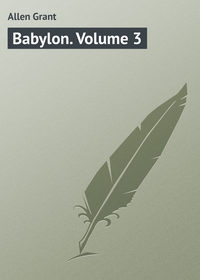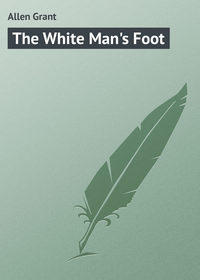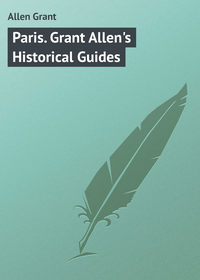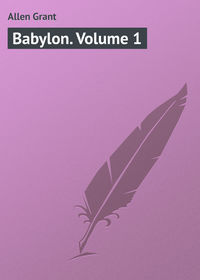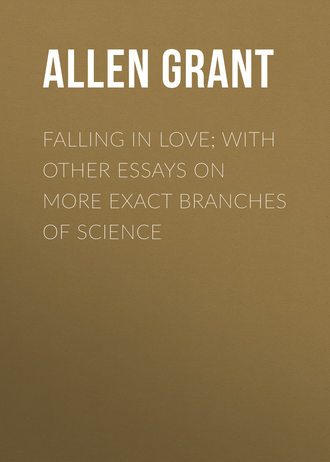 полная версия
полная версияFalling in Love; With Other Essays on More Exact Branches of Science
The real question, then, about the historical toad-in-a-hole narrows itself down in the end merely to this—how long is it credible that a cold-blooded creature might sustain life in a torpid or hibernating condition, without food, and with a very small quantity of fresh air, supplied (let us say) from time to time through an almost imperceptible fissure? It is well known that reptiles and amphibians are particularly tenacious of life, and that some turtles in particular will live for months, or even for years, without tasting food. The common Greek tortoise, hawked on barrows about the streets of London and bought by a confiding British public under the mistaken impression that its chief fare consists of slugs and cockroaches (it is really far more likely to feed upon its purchaser's choicest seakale and asparagus), buries itself in the ground at the first approach of winter, and snoozes away five months of the year in a most comfortable and dignified torpidity. A snake at the Zoo has even been known to live eighteen months in a voluntary fast, refusing all the most tempting offers of birds and rabbits, merely out of pique at her forcible confinement in a strange cage. As this was a lady snake, however, it is possible that she only went on living out of feminine obstinacy, so that this case really counts for very little.
Toads themselves are well known to possess all the qualities of mind and body which go to make up the career of a successful and enduring anchorite. At the best of times they eat seldom and sparingly, while a forty days' fast, like Dr. Tanner's, would seem to them but an ordinary incident in their everyday existence. In the winter they hibernate by burying themselves in the mud, or by getting down cracks in the ground. It is also undoubtedly true that they creep into holes wherever they can find one, and that in these holes they lie torpid for a considerable period. On the other hand, there is every reason to believe that they cannot live for more than a certain fixed and relatively short time entirely without food or air. Dr. Buckland tried a number of experiments upon toads in this manner—experiments wholly unnecessary, considering the trivial nature of the point at issue—and his conclusion was that no toad could get beyond two years without feeding or breathing. There can be very little doubt that in this conclusion he was practically correct, and that the real fine old crusted antediluvian toad-in-a-hole is really a snare and a delusion.
That, however, does not wholly settle the question about such toads, because, even though they may not be all that their admirers claim for them, they may yet possess a very respectable antiquity of their own, and may be very far from the category of mere vulgar cheats and impostors. Because a toad is not as old as Methuselah, it need not follow that he may not be as old as Old Parr; because he does not date back to the Flood, it need not follow that he cannot remember Queen Elizabeth. There are some toads-in-a-hole, indeed, which, however we may account for the origin of their legend, are on the very face of it utterly incredible. For example, there is the favourite and immensely popular toad who was extracted from a perfectly closed hole in a marble mantelpiece. The implication of the legend clearly is that the toad was coeval with the marble. But marble is limestone, altered in texture by pressure and heat, till it has assumed a crystalline structure. In other words we are asked to believe that that toad lived through an amount of fiery heat sufficient to burn him up into fine powder, and yet remains to tell the tale. Such a toad as this obviously deserves no credit. His discoverers may have believed in him themselves, but they will hardly get other people to do so.
Still, there are a great many ways in which it is quite conceivable that toads might get into holes in rocks or trees so as to give rise to the common stories about them, and might even manage to live there for a considerable time with very small quantities of food or air. It must be remembered that from the very nature of the conditions the hole can never be properly examined and inspected until after it has been split open and the toad has been extracted from it. Now, if you split open a tree or a rock, and find a toad inside it, with a cavity which he exactly fills, it is extremely difficult to say whether there was or was not a fissure before you broke the thing to pieces with your hatchet or pickaxe. A very small fissure indeed would be quite sufficient to account for the whole delusion; for if the toad could get a little air to breathe slowly during his torpid period, and could find a few dead flies or worms among the water that trickled scantily into his hole, he could manage to drag out a peaceful and monotonous existence almost indefinitely. Here are a few possible cases, any one of which will quite suffice to give rise to at least as good a toad-in-the-hole as ninety-nine out of a hundred published instances.
An adult toad buries himself in the mud by a dry pond, and gets coated with a hard solid coat of sun-baked clay. His nodule is broken open with a spade, and the toad himself is found inside, almost exactly filling the space within the cavity. He has only been there for a few months at the outside; but the clay is as hard as a stone, and to the bucolic mind looks as if it might have been there ever since the Deluge. Good blue lias clay, which dries as solid as limestone, would perform this trick to perfection; and the toad might easily be relegated accordingly to the secondary ages of geology. Observe, however, that the actual toads so found are not the geological toads we should naturally expect under such remarkable circumstances, but the common everyday toads of modern England. This shows a want of accurate scientific knowledge on the part of the toads which is truly lamentable. A toad who really wished to qualify himself for the post ought at least to avoid presenting himself before a critical eye in the foolish guise of an embodied anachronism. He reminds one of the Roman mother in a popular burlesque, who suspects her son of smoking, and vehemently declares that she smells tobacco, but, after a moment, recollects the historical proprieties, and mutters to herself, apologetically, 'No, not tobacco; that's not yet invented.' A would-be silurian or triassic toad ought, in like manner, to remember that in the ages to whose honours he aspires his own amphibian kind was not yet developed. He ought rather to come out in the character of a ceratodus or a labyrinthodon.
Again, another adult toad crawls into the hollow of a tree, and there hibernates. The bark partially closes over the slit by which he entered, but leaves a little crack by which air can enter freely. The grubs in the bark and other insects supply him from time to time with a frugal repast. There is no good reason why, under such circumstances, a placid and contented toad might not manage to prolong his existence for several consecutive seasons.
Once more, the spawn of toads is very small, as regards the size of the individual eggs, compared with the size of the full-grown animal. Nothing would be easier than for a piece of spawn or a tiny tadpole to be washed into some hole in a mine or cave, where there was sufficient water for its developement, and where the trickling drops brought down minute objects of food, enough to keep up its simple existence. A toad brought up under such peculiar circumstances might pass almost its entire life in a state of torpidity, and yet might grow and thrive in its own sleepy vegetative fashion.
In short, while it would be difficult in any given case to prove to a certainty either that the particular toad-in-a-hole had or had not access to air and food, the ordinary conditions of toad life are exactly those under which the delusive appearance of venerable antiquity would be almost certain frequently to arise. The toad is a nocturnal animal; it lives through the daytime in dark and damp places; it shows a decided liking for crannies and crevices; it is wonderfully tenacious of life; it possesses the power of hibernation; it can live on extremely small quantities of food for very long periods of time together; it buries itself in mud or clay; it passes the early part of its life as a water-haunting tadpole; and last, not least, it can swell out its body to nearly double its natural size by inflating itself, which fully accounts for the stories of toads being taken out of holes every bit as big as themselves. Considering all these things, it would be wonderful indeed if toads were not often found in places and conditions which would naturally give rise to the familiar myth. Throw in a little allowance for human credulity, human exaggeration, and human love of the marvellous, and you have all the elements of a very excellent toad-in-the-hole in the highest ideal perfection.
At the same time I think it quite possible that some toads, under natural circumstances, do really remain in a torpid or semi-torpid condition for a period far exceeding the twenty-four months allowed as the maximum in Dr. Buckland's unpleasant experiments. If the amount of air supplied through a crack or through the texture of the stone were exactly sufficient for keeping the animal alive in the very slightest fashion—the engine working at the lowest possible pressure, short of absolute cessation—I see no reason on earth why a toad might not remain dormant, in a moist place, with perhaps a very occasional worm or grub for breakfast, for at least as long a time as the desert snail slept comfortably in the British Museum. Altogether, while it is impossible to believe the stories about toads that have been buried in a mine for whole centuries, and still more impossible to believe in their being disentombed from marble mantelpieces or very ancient geological formations, it is quite conceivable that some toads-in-a-hole may really be far from mere vulgar impostors, and may have passed the traditional seven years of the Indian philosophers in solitary meditation on the syllable Om, or on the equally significant Ko-ax, Ko-ax of the irreverent Attic dramatist. "Certainly not a centenarian, but perhaps a good seven-year sleeper for all that," is the final verdict which the court is disposed to return, after due consideration of all the probabilities in re the toad-in-a-hole.
A FOSSIL CONTINENT
If an intelligent Australian colonist were suddenly to be translated backward from Collins Street, Melbourne, into the flourishing woods of the secondary geological period—say about the precise moment of time when the English chalk downs were slowly accumulating, speck by speck, on the silent floor of some long-forgotten Mediterranean—the intelligent colonist would look around him with a sweet smile of cheerful recognition, and say to himself in some surprise, 'Why, this is just like Australia.' The animals, the trees, the plants, the insects, would all more or less vividly remind him of those he had left behind him in his happy home of the southern seas and the nineteenth century. The sun would have moved back on the dial of ages for a few million summers or so, indefinitely (in geology we refuse to be bound by dates), and would have landed him at last, to his immense astonishment, pretty much at the exact point whence he first started.
In other words, with a few needful qualifications, to be made hereafter, Australia is, so to speak, a fossil continent, a country still in its secondary age, a surviving fragment of the primitive world of the chalk period or earlier ages. Isolated from all the remainder of the earth about the beginning of the tertiary epoch, long before the mammoth and the mastodon had yet dreamt of appearing upon the stage of existence, long before the first shadowy ancestor of the horse had turned tail on nature's rough draft of the still undeveloped and unspecialised lion, long before the extinct dinotheriums and gigantic Irish elks and colossal giraffes of late tertiary times had even begun to run their race on the broad plains of Europe and America, the Australian continent found itself at an early period of its development cut off entirely from all social intercourse with the remainder of our planet, and turned upon itself, like the German philosopher, to evolve its own plants and animals out of its own inner consciousness. The natural consequence was that progress in Australia has been absurdly slow, and that the country as a whole has fallen most woefully behind the times in all matters pertaining to the existence of life upon its surface. Everybody knows that Australia as a whole is a very peculiar and original continent; its peculiarity, however, consists, at bottom, for the most part in the fact that it still remains at very nearly the same early point of development which Europe had attained a couple of million years ago or thereabouts. "Advance, Australia," says the national motto; and, indeed, it is quite time nowadays that Australia should advance; for, so far, she has been left out of the running for some four mundane ages or so at a rough computation.
Example, says the wisdom of our ancestors, is better than precept; so perhaps, if I take a single example to start with, I shall make the principle I wish to illustrate a trifle clearer to the European comprehension. In Australia, when Cook or Van Diemen first visited it, there were no horses, cows, or sheep; no rabbits, weasels, or cats; no indigenous quadrupeds of any sort except the pouched mammals or marsupials, familiarly typified to every one of us by the mamma kangaroo in Regent's Park, who carries the baby kangaroos about with her, neatly deposited in the sac or pouch which nature has provided for them instead of a cradle. To this rough generalisation, to be sure, two special exceptions must needs be made; namely, the noble Australian black-fellow himself, and the dingo or wild dog whose ancestors no doubt came to the country in the same ship with him, as the brown rat came to England with George I. of blessed memory. But of these two solitary representatives of the later and higher Asiatic fauna 'more anon'; for the present we may regard it as approximately true that aboriginal and unsophisticated Australia in the lump was wholly given over, on its first discovery, to kangaroos, phalangers, dasyures, wombats, and other quaint marsupial animals, with names as strange and clumsy as their forms.
Now, who and what are the marsupials as a family, viewed in the dry light of modern science? Well, they are simply one of the very oldest mammalian families, and therefore, I need hardly say, in the levelling and topsy-turvy view of evolutionary biology, the least entitled to consideration or respect from rational observers. For of course in the kingdom of science the last shall be first, and the first last; it is the oldest families that are accounted the worst, while the best families mean always the newest. Now, the earliest mammals to appear on earth were creatures of distinctly marsupial type. As long ago as the time when the red marl of Devonshire and the blue lias of Lyme Regis were laid down on the bed of the muddy sea that once covered the surface of Dorset and the English Channel, a little creature like the kangaroo rats of Southern Australia lived among the plains of what is now the south of England. In the ages succeeding the deposition of the red marl Europe seems to have been broken up into an archipelago of coral reefs and atolls; and the islands of this ancient oolitic ocean were tenanted by numbers of tiny ancestral marsupials, some of which approached in appearance the pouched ant-eaters of Western Australia, while others resembled rather the phalangers and wombats, or turned into excellent imitation carnivores, like our modern friend the Tasmanian devil. Up to the end of the time when the chalk deposits of Surrey, Kent, and Sussex were laid down, indeed, there is no evidence of the existence anywhere in the world of any mammals differing in type from those which now inhabit Australia. In other words, so far as regards mammalian life, the whole of the world had then already reached pretty nearly the same point of evolution that poor Australia still sticks at.
About the beginning of the tertiary period, however, just after the chalk was all deposited, and just before the comparatively modern clays and sandstones of the London basin began to be laid down, an arm of the sea broke up the connection which once subsisted between Australia and the rest of the world, probably by a land bridge, viâ Java, Sumatra, the Malay peninsula, and Asia generally. 'But how do you know,' asks the candid inquirer, 'that such a connection ever existed at all?' Simply thus, most laudable investigator—because there are large land mammals in Australia. Now, large land mammals do not swim across a broad ocean. There are none in New Zealand, none in the Azores, none in Fiji, none in Tahiti, none in Madeira, none in Teneriffe—none, in short, in any oceanic island which never at any time formed part of a great continent. How could there be, indeed? The mammals must necessarily have got there from somewhere; and whenever we find islands like Britain, or Japan, or Newfoundland, or Sicily, possessing large and abundant indigenous quadrupeds, of the same general type as adjacent continents, we see at once that the island must formerly have been a mere peninsula, like Italy or Nova Scotia at the present day. The very fact that Australia incloses a large group of biggish quadrupeds, whose congeners once inhabited Europe and America, suffices in itself to prove beyond question that uninterrupted land communication must once have existed between Australia and those distant continents.
In fact, to this day a belt of very deep sea, known as Wallace's Line, from the great naturalist who first pointed out its far-reaching zoological importance, separates what is called by science 'the Australian province' on the southwest from 'the Indo-Malayan province' to the north and east of it. This belt of deep sea divides off sharply the plants and animals of the Australian type from those of the common Indian and Burmese pattern. South of Wallace's Line we now find several islands, big and small, including New Guinea, Australia, Tasmania, the Moluccas, Celebes, Timor, Amboyna, and Banda. All these lands, whose precise geographical position on the map must of course be readily remembered, in this age of school boards and universal examination, by every pupil-teacher and every Girton girl, are now divided by minor straits of much shallower water; but they all stand on a great submarine bank, and obviously formed at one time parts of the same wide Australian continent, because animals of the Australian type are still found in every one of them. No Indian or Malayan animal, however, of the larger sort (other than birds) is to be discovered anywhere south of Wallace's Line. That narrow belt of deep sea, in short, forms an ocean barrier which has subsisted there without alteration ever since the end of the secondary period. From that time to this, as the evidence shows us, there has never been any direct land communication between Australia and any part of the outer world beyond that narrow line of division.
Some years ago, in fact, a clever hoax took the world by surprise for a moment, under the audacious title of 'Captain Lawson's Adventures in New Guinea.' The gallant captain, or his unknown creator in some London lodging, pretended to have explored the Papuan jungles, and there to have met with marvellous escapes from terrible beasts of the common tropical Asiatic pattern—rhinoceroses, tigers, monkeys, and leopards. Everybody believed the new Munchausen at first, except the zoologists. Those canny folks saw through the wicked hoax on the very first blush of it. If there were rhinoceroses in Papua, they must have got there by an overland route. If there had ever been a land connection between New Guinea and the Malay region, then, since Australian animals range into New Guinea, Malayan animals would have ranged into Australia, and we should find Victoria and New South Wales at the present day peopled by tapirs, orang-outangs, wild boars, deer, elephants, and squirrels, like those which now people Borneo, instead of, or side by side with, the kangaroos, wombats, and other marsupials, which, as we know, actually form the sole indigenous mammalian population of Greater Britain beneath the Southern Cross. Of course, in the end, the mysterious and tremendous Captain Lawson proved to be a myth, an airy nothing upon whom imagination had bestowed a local habitation (in New Guinea) and a name (not to be found in the Army List). Wallace's Line was saved from reproach, and the intrusive rhinoceros was banished without appeal from the soil of Papua.
After the deep belt of open sea was thus established between the bigger Australian continent and the Malayan region, however, the mammals of the great mainlands continued to develop on their own account, in accordance with the strictest Darwinian principles, among the wider plains of their own habitats. The competition there was fiercer and more general; the struggle for life was bloodier and more arduous. Hence, while the old-fashioned marsupials continued to survive and to evolve slowly along their own lines in their own restricted southern world, their collateral descendants in Europe and Asia and America or elsewhere went on progressing into far higher, stronger, and better adapted forms—the great central mammalian fauna. In place of the petty phalangers and pouched ant-eaters of the oolitic period, our tertiary strata in the larger continents show us a rapid and extraordinary development of the mammalian race into monstrous creatures, some of them now quite extinct, and some still holding their own undisturbed in India, Africa, and the American prairies. The palæotherium and the deinoceras, the mastodon and the mammoth, the huge giraffes and antelopes of sunnier times, succeed to the ancestral kangaroos and wombats of the secondary strata. Slowly the horses grow more horse-like, the shadowy camel begins to camelise himself, the buffaloes acquire the rudiments of horns, the deer branch out by tentative steps into still more complicated and more complicated antlers. Side by side with this wonderful outgrowth of the mammalian type, in the first plasticity of its vigorous youth, the older marsupials die away one by one in the geological record before the faces of their more successful competitors; the new carnivores devour them wholesale, the new ruminants eat up their pastures, the new rodents outwit them in the modernised forests. At last the pouched creatures all disappear utterly from all the world, save only Australia, with the solitary exception of a single advanced marsupial family, the familiar opossum of plantation melodies. And the history of the opossum himself is so very singular that it almost deserves to receive the polite attention of a separate paragraph for its own proper elucidation.
For the opossums form the only members of the marsupial class now living outside Australia; and yet, what is at least equally remarkable, none of the opossums are found per contra in Australia itself. They are, in fact, the highest and best product of the old dying marsupial stock, specially evolved in the great continents through the fierce competition of the higher mammals then being developed on every side of them. Therefore, being later in point of time than the separation, they could no more get over to Australia than the elephants and tigers and rhinoceroses could. They are the last bid for life of the marsupial race in its hopeless struggle against its more developed mammalian cousins. In Europe and Asia the opossums lived on lustily, in spite of competition, during the whole of the Eocene period, side by side with hog-like creatures not yet perfectly piggish, with nondescript animals, half horse half tapir, and with hornless forms of deer and antelopes, unprovided, so far, with the first rudiment of budding antlers. But in the succeeding age they seem to disappear from the eastern continent, though in the western, thanks to their hand-like feet, opposable thumb, and tree-haunting life, they still drag out a precarious existence in many forms from Virginia to Chili, and from Brazil to California. It is worth while to notice, too, that whereas the kangaroos and other Australian marsupials are proverbially the very stupidest of mammals, the opossums, on the contrary, are well known to those accurate observers of animal psychology, the plantation negroes, to be the very cleverest, cunningest, and slyest of American quadrupeds. In the fierce struggle for life of the crowded American lowlands, the opossum was absolutely forced to acquire a certain amount of Yankee smartness, or else to be improved off the face of the earth by the keen competition of the pouchless mammals.






